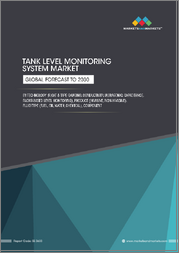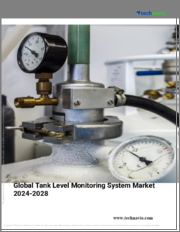
|
시장보고서
상품코드
1800244
무선 탱크 레벨 모니터링 시장 : 예측(2025-2030년)Wireless Tank Level Monitoring Market - Forecasts fom 2025 to 2030 |
||||||
무선 탱크 레벨 모니터링 시장은 CAGR 6.32%로, 2025년 9억 8,712만 달러에서 2030년에는 13억 4,107만 달러로 성장할 것으로 예측됩니다.
무선 탱크 레벨 모니터링 세계 시장은 석유, 가스, 화학 및 기타 가공 산업에서 효율적인 액체 관리에 대한 수요가 증가함에 따라 2025년부터 2030년까지 크게 성장할 것으로 예측됩니다. 무선 탱크 레벨 모니터링 시스템은 센서, 송신기, 스마트폰이나 PC와 같은 기기의 용도으로 구성되며, 휴대폰이나 위성 네트워크를 통해 액체 레벨을 실시간으로 모니터링할 수 있습니다. 이러한 시스템은 낭비, 도난, 유출로 인한 환경파괴를 방지하는 데 필수적입니다. 이 시장은 특히 급속한 산업 성장이 예상되는 아시아태평양에서 안전하고 신뢰할 수 있는 탱크 관리의 필요성에 의해 주도되고 있습니다. 데이터 부정확성, 고장난 장비의 높은 교체 비용 등을 문제점으로 꼽을 수 있습니다.
시장 성장 촉진요인
효율적인 탱크 관리에 대한 수요 증가
석유, 가스, 화학 등 처리 산업에서는 안전하고 효율적인 액체 관리를 위해 무선 탱크 레벨 모니터링 시스템을 도입하고 있습니다. 펑크, 부식, 수작업에 의한 과충전 등으로 인한 누출은 경제적 손실과 환경파괴를 포함한 심각한 위험을 초래합니다. 실시간 모니터링을 통해 수역에 위험한 액체가 유출되는 등의 재앙을 미연에 방지할 수 있습니다. 도난을 줄이고 재고 관리를 최적화하기 위한 정확한 추적의 필요성이 특히 석유와 같은 고가의 액체를 취급하는 산업에서 수요를 촉진하고 있습니다. 이러한 추세는 업계가 업무 효율성과 환경 준수를 우선시함에 따라 시장 성장을 가속할 것으로 예측됩니다.
석유 및 화학 산업의 확장
특히 아시아태평양의 석유 및 화학 산업의 급격한 성장은 주요 촉진요인입니다. 인도 브랜드 주식 재단(IBEF)에 따르면, 인도에서 화학 부문은 연평균 9.3%의 성장률을 보이며 2025년 3,040억 달러에 달할 것으로 예측됩니다. 이러한 확대는 에탄올 플랜트와 같은 인프라에 대한 투자와 함께 액체 저장을 효율적으로 관리할 수 있는 고도의 모니터링 시스템의 필요성을 증가시키고 있습니다. 산업 현대화가 진행 중인 중국에서도 비슷한 추세를 보이고 있으며, 무선 탱크 레벨 모니터링 시스템에 대한 수요가 더욱 증가하고 있습니다.
시장 성장 억제요인
무선 탱크 레벨 모니터링 시스템에서 전송되는 데이터가 부정확할 수 있고, 이로 인해 재고가 크게 손실되거나 조작 실수가 발생할 수 있기 때문에 시장은 문제에 직면해 있습니다. 센서나 송신기에 결함이 있는 경우, 보증 기간이 짧은 경우가 많아 고가의 교체가 필요하며, 비용에 민감한 시장에서의 채택에 영향을 미칠 수 있습니다. 또한, 이러한 시스템을 기존 인프라와 통합하는 것은 특히 중소기업의 경우 복잡하고 비용이 많이 들 수 있습니다. 센서의 신뢰성을 향상시키고 비용 효율적인 솔루션을 제공하여 이러한 문제를 해결하는 것이 시장의 지속적인 확장에 필수적입니다.
목차
제1장 주요 요약
제2장 시장 현황
- 시장 개요
- 시장의 정의
- 조사 범위
- 시장 세분화
제3장 비즈니스 상황
- 시장 성장 촉진요인
- 시장 성장 억제요인
- 시장 기회
- Porter의 Five Forces 분석
- 업계 밸류체인 분석
- 정책 및 규제
- 전략적 제안
제4장 기술 전망
제5장 무선 탱크 레벨 모니터링 시장 : 기술별
- 서론
- 초음파
- 레이더
- 정전용량 센서
- 플로트 및 테이프 게이지
- 정수압
- 기타
제6장 무선 탱크 레벨 모니터링 시장 : 업계별
- 서론
- 석유 및 가스
- 화학제품
- 발전소
- 광업
- 물 및 폐수 관리
- 식품 및 음료
- 기타
제7장 무선 탱크 레벨 모니터링 시장 : 지역별
- 서론
- 북미
- 미국
- 캐나다
- 멕시코
- 남미
- 브라질
- 아르헨티나
- 기타
- 유럽
- 영국
- 독일
- 프랑스
- 기타
- 중동 및 아프리카
- 사우디아라비아
- 아랍에미리트(UAE)
- 이스라엘
- 기타
- 아시아태평양
- 일본
- 중국
- 인도
- 한국
- 인도네시아
- 태국
- 기타
제8장 경쟁 환경과 분석
- 주요 기업과 전략 분석
- 시장 점유율 분석
- 합병, 인수, 합의 및 협업
- 경쟁 대시보드
제9장 기업 개요
- Schneider Electric
- Emerson Electric Co
- TankScan(ITEK, LLC)
- Digi International
- Gauging Systems
- TE Connectivity
- Oriel Systems
- Siemens
- Nanolike
- OleumTech
- Leidos
제10장 조사 방법
LSH 25.09.03The wireless tank level monitoring market is expected to grow from USD 987.120 million in 2025 to USD 1,341.070 million in 2030, at a CAGR of 6.32%.
The global wireless tank level monitoring market is poised for significant growth from 2025 to 2030, driven by the increasing demand for efficient liquid management in processing industries such as oil, gas, and chemicals. Wireless tank level monitoring systems, comprising sensors, transmitters, and applications on devices like smartphones or PCs, enable real-time monitoring of liquid levels over cellular or satellite networks. These systems are critical for preventing wastage, theft, and environmental hazards caused by spills. The market is propelled by the need for safe and reliable tank management, particularly in Asia-Pacific, where rapid industrial growth is expected. Challenges include data inaccuracies and high replacement costs for faulty equipment.
Market Drivers
Growing Demand for Efficient Tank Management
Processing industries, including oil, gas, and chemicals, are increasingly adopting wireless tank level monitoring systems to ensure safe and efficient liquid management. Leaks from punctures, corrosion, or manual overfilling pose significant risks, including financial losses and environmental damage. Real-time monitoring enables proactive measures to prevent mishaps, such as spills of hazardous liquids into water bodies. The need for accurate tracking to mitigate theft and optimize inventory management is driving demand, particularly in industries with high-value liquids like oil. This trend is expected to fuel market growth as industries prioritize operational efficiency and environmental compliance.
Expansion of Oil and Chemical Industries
The rapid growth of oil and chemical industries, especially in Asia-Pacific, is a key driver. In India, the chemical sector is projected to grow at a compound annual growth rate (CAGR) of 9.3%, reaching USD 304 billion by 2025, according to the Indian Brand Equity Foundation (IBEF). This expansion, coupled with investments in infrastructure like ethanol plants, increases the need for advanced monitoring systems to manage liquid storage effectively. Similar trends in China, driven by industrial modernization, further boost demand for wireless tank level monitoring systems.
Market Restraints
The market faces challenges due to potential inaccuracies in data transmitted by wireless tank level monitoring systems, which can lead to significant inventory losses or operational errors. Faulty sensors or transmitters, often with short warranty periods, may require costly replacements, impacting adoption in cost-sensitive markets. Additionally, integrating these systems with existing infrastructure can be complex and expensive, particularly for smaller enterprises. Addressing these issues through improved sensor reliability and cost-effective solutions will be critical for sustained market expansion.
Market Segmentation
By Application
The market is segmented into oil and gas, chemicals, water and wastewater, food and beverage, and others. Oil and gas dominate due to the high value of liquids and the need for precise monitoring to prevent losses and ensure safety. The chemical industry is a fast-growing segment, driven by its expansion in Asia-Pacific and the need for safe handling of hazardous substances.
By Component
The market includes sensors, transmitters, and software applications. Sensors and transmitters are critical for accurate level detection and data transmission, while software applications provide user interfaces for real-time monitoring on devices like smartphones or PCs.
By Geography
The market is segmented into North America, Europe, Asia-Pacific, South America, and the Middle East and Africa. Asia-Pacific is expected to hold the largest share, driven by rapid growth in the oil and chemical industries in China and India. North America and Europe are significant markets, supported by advanced industrial infrastructure and stringent environmental regulations. South America and the Middle East and Africa are emerging markets, fueled by increasing investments in processing industries.
The wireless tank level monitoring market is set for robust growth from 2025 to 2030, driven by the need for efficient liquid management in oil, gas, and chemical industries, particularly in Asia-Pacific. Despite challenges from data inaccuracies and high equipment costs, the market's outlook remains positive, supported by industrial expansion and environmental compliance needs. Industry players must focus on enhancing sensor reliability, reducing costs, and developing scalable solutions to capitalize on the growing demand for wireless tank level monitoring systems.
Key Benefits of this Report:
- Insightful Analysis: Gain detailed market insights covering major as well as emerging geographical regions, focusing on customer segments, government policies and socio-economic factors, consumer preferences, industry verticals, and other sub-segments.
- Competitive Landscape: Understand the strategic maneuvers employed by key players globally to understand possible market penetration with the correct strategy.
- Market Drivers & Future Trends: Explore the dynamic factors and pivotal market trends and how they will shape future market developments.
- Actionable Recommendations: Utilize the insights to exercise strategic decisions to uncover new business streams and revenues in a dynamic environment.
- Caters to a Wide Audience: Beneficial and cost-effective for startups, research institutions, consultants, SMEs, and large enterprises.
What do businesses use our reports for?
Industry and Market Insights, Opportunity Assessment, Product Demand Forecasting, Market Entry Strategy, Geographical Expansion, Capital Investment Decisions, Regulatory Framework & Implications, New Product Development, Competitive Intelligence
Report Coverage:
- Historical data from 2020 to 2024 & forecast data from 2025 to 2030
- Growth Opportunities, Challenges, Supply Chain Outlook, Regulatory Framework, and Trend Analysis
- Competitive Positioning, Strategies, and Market Share Analysis
- Revenue Growth and Forecast Assessment of segments and regions including countries
- Company Profiling (Strategies, Products, Financial Information, and Key Developments among others.
Segmentation
By Technology
- Ultrasonic
- Radar
- Capacitive sensors
- Float and Tape Gauge
- Hydrostatic
- Others
By Industry
- Oil and Fuel
- Chemical
- Power plants
- Mining
- Others
By Geography
- North America
- US
- Canada
- Mexico
- South America
- Brazil
- Argentina
- Others
- Europe
- Germany
- France
- UK
- Others
- Middle East and Africa
- Saudi Arabia
- UAE
- Others
- Asia Pacific
- China
- India
- Japan
- South Korea
- Taiwan
- Thailand
- Indonesia
TABLE OF CONTENTS
1. EXECUTIVE SUMMARY
2. MARKET SNAPSHOT
- 2.1. Market Overview
- 2.2. Market Definition
- 2.3. Scope of the Study
- 2.4. Market Segmentation
3. BUSINESS LANDSCAPE
- 3.1. Market Drivers
- 3.2. Market Restraints
- 3.3. Market Opportunities
- 3.4. Porter's Five Forces Analysis
- 3.5. Industry Value Chain Analysis
- 3.6. Policies and Regulations
- 3.7. Strategic Recommendations
4. TECHNOLOGICAL OUTLOOK
5. WIRELESS TANK LEVEL MONITORING MARKET BY TECHNOLOGY
- 5.1. Introduction
- 5.2. Ultrasonic
- 5.3. Radar
- 5.4. Capacitive sensors
- 5.5. Float and Tape Gauge
- 5.6. Hydrostatic
- 5.7. Others
6. WIRELESS TANK LEVEL MONITORING MARKET BY INDUSTRY
- 6.1. Introduction
- 6.2. Oil and Gas
- 6.3. Chemical
- 6.4. Power plants
- 6.5. Mining
- 6.6. Water and Wastewater Management
- 6.7. Food and Beverages
- 6.8. Others
7. WIRELESS TANK LEVEL MONITORING MARKET BY GEOGRAPHY
- 7.1. Introduction
- 7.2. North America
- 7.2.1. USA
- 7.2.2. Canada
- 7.2.3. Mexico
- 7.3. South America
- 7.3.1. Brazil
- 7.3.2. Argentina
- 7.3.3. Others
- 7.4. Europe
- 7.4.1. United Kingdom
- 7.4.2. Germany
- 7.4.3. France
- 7.4.4. Others
- 7.5. Middle East & Africa
- 7.5.1. Saudi Arabia
- 7.5.2. UAE
- 7.5.3. Israel
- 7.5.4. Others
- 7.6. Asia Pacific
- 7.6.1. Japan
- 7.6.2. China
- 7.6.3. India
- 7.6.4. South Korea
- 7.6.5. Indonesia
- 7.6.6. Thailand
- 7.6.7. Others
8. COMPETITIVE ENVIRONMENT AND ANALYSIS
- 8.1. Major Players and Strategy Analysis
- 8.2. Market Share Analysis
- 8.3. Mergers, Acquisitions, Agreements, and Collaborations
- 8.4. Competitive Dashboard
9. COMPANY PROFILES
- 9.1. Schneider Electric
- 9.2. Emerson Electric Co
- 9.3. TankScan ( ITEK, LLC)
- 9.4. Digi International
- 9.5. Gauging Systems
- 9.6. TE Connectivity
- 9.7. Oriel Systems
- 9.8. Siemens
- 9.9. Nanolike
- 9.10. OleumTech
- 9.11. Leidos
















